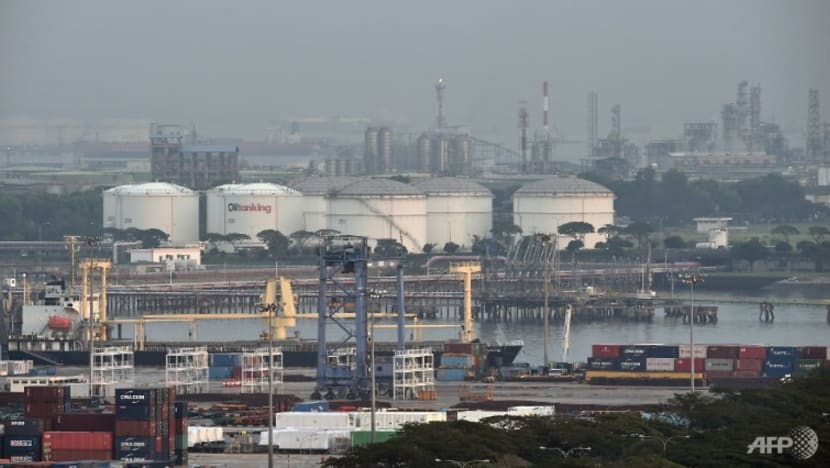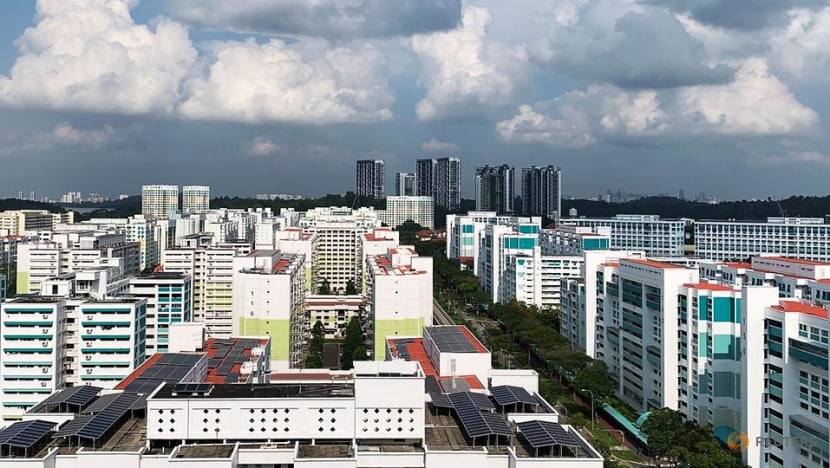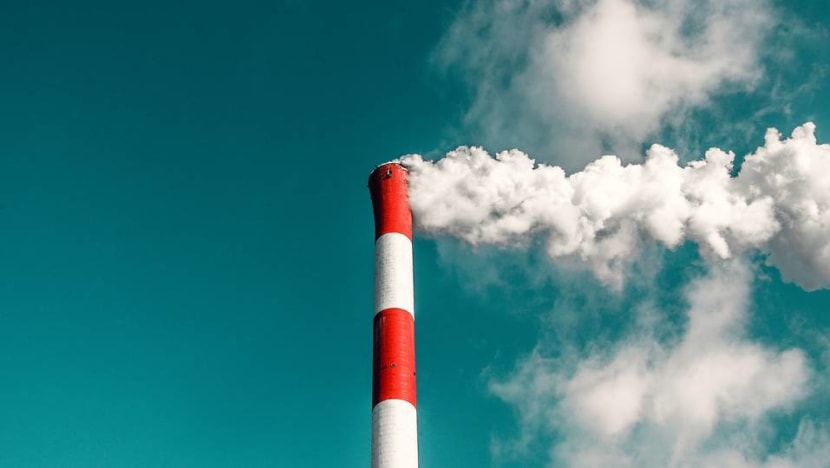commentary Commentary
Commentary: Forget bamboo straws. Let’s name the elephants in the room of Singapore’s climate debate
While Singapore contributes less than 0.1 per cent of global greenhouse gas emissions, the world can no longer afford the blame game and finger-pointing, says Yale-NUS’ Angel Hsu.

File photo of infrastructure on Jurong Island. (Photo: AFP)
SINGAPORE: Countries met in Madrid this month to finalise the details of the Paris Agreement before it officially goes into effect next year.
But we’re already several strides behind the start line.
The latest scientific research that evaluates the “emissions gap” – the distance between current emissions levels and where we need to be to contain global temperature rise within 1.5 to 2 degrees Celsius – has produced an ominous warning: We need to increase our efforts five-fold to tackle climate change.
READ: UN climate conference offered countries better understanding despite lack of overall consensus: Masagos
At first glance, Singapore seems to be a David compared to other climate Goliaths. The tiny island city-state contributes less than 0.1 per cent of total global greenhouse gas emissions, so it may seem inconsequential to be discussing the country’s climate mitigation efforts.
Yet, the world can no longer afford the blame game and finger-pointing. Singapore’s per capita greenhouse gas emissions, at close to 10 tonnes per person, is still above the world average of around 7 tonnes.
READ: Commentary: As time runs out on the climate crisis, Singapore prepares to address the cost of adapting
READ: Commentary: Singapore’s climate change fight must be clear about these facts
Moreover, based on GDP per capita, Singapore is the third richest country in the world, positioning it as a leader in Southeast Asia with the capacity – and perhaps, responsibility – to dig deeper on climate action.
So, what should Singapore do to meaningfully contribute to global climate change mitigation?
THE MAIN CONTRIBUTOR TO SINGAPORE’S EMISSIONS
As individuals, we can examine our own actions such as taking public transport, avoiding airplane travel, and eating less meat. Plastic straws are increasingly scarce in Singapore, as more than 270 businesses have stopped providing them to customers.
But, when considering the scale of the climate challenge, which requires halving global emissions by 2030 and achieving net-zero emissions by 2050, these actions are a drop in the bucket.

A closer look at Singapore’s emissions profile shows that households account for less than 20 per cent of carbon emissions. In fact, the share of households in the country’s carbon footprint has decreased since 2000.
The primary culprit for Singapore’s carbon emissions is not difficult to identify.
Looking out of my window in western Singapore, I can see Jurong Island’s petroleum and oil refining industry. It makes this country the world’s fifth largest refinery export hub, responsible for nearly half of national greenhouse emissions.
READ: Commentary: Have Singaporeans been mollycoddled on climate change?
We can continue to reject plastic straws, but to significantly reduce its greenhouse gas emissions and future-proof its economy, Singapore must adopt a strategy to shift its reliance on the petroleum and refinery industry.
Global clean energy investment is at an all-time high. It topped US$300 billion in 2017 and is expected to increase over ten-fold by 2030. Singapore is missing out on a key investment opportunity, if it continues to hinge its economy on the oil and petroleum industry.
In fact, new energy innovations, including battery storage, electric vehicles, and energy efficient appliances, will create a business opportunity of nearly US$2 trillion by 2030 in Asia alone.
LISTEN: Heart of the Matter podcast: Talking about the Madrid climate talks, what happened and what’s next?
Singapore’s Minister for the Environment and Water Resources Masagos Zulkifli has stated that the clean energy sector can create over 2 million jobs in Southeast Asia by 2030.
Instead of banking on the petroleum industry in a carbon constrained future, Singapore should refine its comparative advantage in developing, financing, and diffusing solutions for a clean energy future.
READ: Commentary: Singapore’s dreams of becoming a solar-powered nation have almost arrived
WHAT’S NEEDED? A MORE AGGRESSIVE SOLAR ENERGY ROADMAP
Singapore can embark on this long-term pathway through various short- to medium-term strategies.

First, the country can create a more aggressive solar energy roadmap. Currently, 95 per cent of the country’s electricity is from imported natural gas, a major reason global carbon emissions are a record high in 2019.
Despite the rapid decline in the price of solar photovoltaic (PV) globally, solar PV accounts for less than 1 per cent of total electricity generation capacity in Singapore.
READ: Commentary: Big Oil talks a good low-carbon game but does little to back that up
A significantly higher solar energy target is also likely to be in Singapore’s economic interest as the world’s most influential companies are increasingly committing to switching to 100 per cent renewable energy over the next decade or so.
A PUSH FOR GREEN BUILDINGS
Second, Singapore can complement its ambition of having 80 per cent of its buildings certified green by 2030 with a target for net-zero energy buildings.
A recent study found that a solar panel integrated façade can meet the entire electricity requirement of a landed house and over three-quarters of an HDB building’s demand. By using daylight and natural cooling, such a design can simultaneously achieve economic and environmental objectives.
Commentary: I care about climate change. I don't wish to live in a Waterworld like Kevin Costner
Singapore has already benefited from its timely push towards green buildings and leadership in this area by greening over one-third of its building stock. Investment in net-zero emissions buildings will not only pave the way for robust mitigation but also complement the Smart Nation initiative by making Singapore a living laboratory for clean energy innovation.
Globally, we need all new buildings to be net-zero or near net-zero to reign in emissions.
A HIGHER CARBON TAX
Third, Singapore can adopt a carbon price trajectory that is better aligned with the latest research on climate change.

The 2018 UNEP Emissions Gap Report indicated that a price of US$40 and US$100 per tonne of carbon dioxide is necessary for realising the 2 degree and the 1.5 degree Celsius pathway, respectively.
Singapore’s current carbon price of S$5 – and even the intended price of S$10 to S$15 by 2030 – falls short not only of the global average of US$21.50 (S$29.50), but also that of several other high-income economies, such as California and Tokyo.
SINGAPORE NEEDS TO TAKE ACTION TODAY
As long as the country maintains its oil and petrochemical exports as the centre of its economy, climate action focused on other sectors will be akin to using a spoon to drain an overflowing bathtub.
So far, Singapore’s climate mitigation plan has focused on increasing energy efficiency, transitioning from oil to natural gas for electricity, making public transport more convenient, and greening its buildings.
READ: Commentary: What if governments and firms measure the one thing that matters most – carbon productivity?
In the past, emissions reductions achieved through these strategies, while substantial, have been offset by an increase in manufacturing and oil exports. Singapore’s low carbon price, reliance on natural gas, and further growth in manufacturing will only ensure the status quo.
In his National Day Rally speech this year, Prime Minister Lee Hsien Loong committed to long-term solutions to climate change. While this vision is laudable, framing climate change as “a 50- to 100-year problem” with “a 50- to 100-year solution” is too far-sighted.
READ: Commentary: Climate action is our generation’s 1965
We need Singapore to take action today and not delay plans for a 50- to a 100-year timeframe. Clutching at straws – whether bamboo or plastic – while dodging much harder climate choices is short-sighted.
If any country has the financial resources, technological capacity, and long-term vision to demonstrate leadership in climate action, it is Singapore. Now, it is critical for Singapore to stand up to the challenge.
Angel Hsu is Assistant Professor of Social Sciences (Environmental Studies) at Yale-NUS College.












